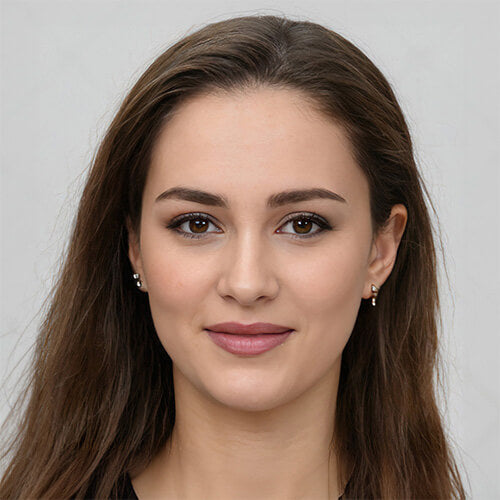To prevent forehead acne and pimples caused by durags, it is important to understand the underlying causes and triggers of acne. Excessive sebum production, inflammation, and bacterial growth are common culprits. The forehead, being prone to acne, is particularly vulnerable due to oil glands and hair products that can clog pores.
To keep your forehead acne-free, follow these simple steps:
1. Wash your face with a gentle cleanser twice daily to remove excess oil and impurities.
2. Avoid using oils or pomade products on your hair, as they can seep onto your forehead and clog pores.
3. Wash your hair regularly to prevent the buildup of oils and dirt contributing to acne.
4. Refrain from touching your face unnecessarily, as this can transfer bacteria and oils from your hands onto your forehead.
5. Use noncomedogenic skincare products that won't clog your pores and exacerbate acne.
Avoid wearing tight durags to prevent tension headaches and indentations on your forehead. Regularly washing durags is important for maintaining skin health by reducing the accumulation of oils and bacteria. For detailed guidelines on properly washing and tying your durag, explore our articles on 'How to Wash a Durag' and 'How to Tie a Durag.'
It's also important to consider the role of hormonal changes and hair products in contributing to forehead acne bumps. Hormonal fluctuations can trigger excessive sebum production while irritating hair products can cause inflammation and clog pores.
To enhance your skincare routine, incorporate products with effective ingredients such as salicylic acid, which helps cleanse pores and fight inflammation, benzoyl peroxide, which manages excess bacteria, and green tea extract, which prevents dryness.
Remember, chemical peels are not recommended for treating forehead acne as they can cause further inflammation and irritation. Stick to a consistent skincare routine and follow these tips to prevent forehead pimples and pimples caused by durags.

The Causes of Forehead Acne from Durags
Forehead acne from durags can be caused by various factors, such as the clogging of pores due to excessive sebum production, inflammation triggered by do-rag friction, and bacteria growth on the forehead. The oil glands on the forehead are particularly prone to acne as they can become easily clogged by hair products and durags, forming small pimples and blackheads.
When you wear a durag, the friction between the fabric and your forehead can irritate the skin, causing inflammation and breakouts. This can be further exacerbated if the durag is too tight, leading to tension headaches and indentations on the forehead. Additionally, bacteria that naturally reside on the skin can multiply and thrive in the warm and humid environment created by wearing a durag, contributing to the development of acne.
It's essential to adopt a regular skincare routine to prevent forehead pimples. Start by cleansing your face twice daily with a gentle cleanser to remove excess oil, dirt, and bacteria. Avoid using heavy oils or pomade products on your hair, as they can transfer onto your forehead and clog pores. It is also important to wash your hair regularly to keep it clean and prevent oil buildup.
Opt for noncomedogenic options that won't clog pores when choosing skincare products. These products are specifically formulated to be less likely to cause acne. Additionally, try to minimize touching your face throughout the day, as it can transfer bacteria and oils onto your forehead. Following these skin care tips and avoiding tight durags can help prevent forehead acne and maintain a healthy complexion.
Cause of Forehead Pimples From Durags
- Excessive sebum production: The oil glands on the forehead can produce too much sebum, leading to clogged pores and acne.
- Inflammation: The friction between the durag fabric and the forehead can cause irritation and inflammation, contributing to acne breakouts.
- Bacterial growth: The warm and humid environment created by wearing a durag can promote the growth of bacteria, leading to acne formation.
Skincare Tips to Prevent Forehead Acne from Durags
To prevent forehead acne caused by durags, following a consistent skincare routine that involves washing your face twice a day with a gentle cleanser and avoiding oily or pomade-based hair products is essential. Washing your face with a gentle cleanser helps to remove dirt, oil, and impurities that can clog pores and contribute to acne formation. Choose a cleanser specifically formulated for your skin type, whether dry, oily, or combination.
In addition to regular cleansing, it's important to avoid using oil or pomade products on your hair, as these can transfer to your forehead and clog your pores. Opt for noncomedogenic hair products, which are less likely to cause acne breakouts. Noncomedogenic products are formulated to not clog pores, reducing the risk of acne formation.
| Skincare Tips to Prevent Forehead Acne from Durags |
|---|
| Wash your face twice a day with a gentle cleanser |
| Opt for non-comedogenic hair products |
| Avoid using oily or pomade-based hair products |
| Avoid touching your face to prevent transferring bacteria and oil |
Another important tip is to avoid touching your face, as your hands can transfer bacteria and oil to your forehead, leading to acne breakouts. Keep your hands clean and avoid unnecessarily touching your face throughout the day.
By incorporating these skincare tips into your daily routine, you can effectively prevent forehead acne caused by durags. Remember to cleanse your face, choose non-comedogenic hair products, and avoid touching your face. Consistency is key, so stick to your skincare routine for best results.

Avoiding Durag-Related Issues for Skin Health
While durags are a popular hair accessory, avoiding wearing them too tightly is crucial to prevent tension headaches and unsightly forehead indentations. Excessive pressure from tight durags can restrict blood flow to the head, leading to discomfort and headaches. To maintain healthy skin, it is recommended to choose durags that provide a comfortable and secure fit without excessive tightness.
Regularly washing your durags is another important aspect of preventing forehead acne. Durags can accumulate sweat, dirt, and oil, which creates an ideal environment for acne-causing bacteria to thrive. By washing your durags regularly, you can ensure they are clean and free from these acne-causing factors. Following the care instructions provided with your durags is recommended to maintain their cleanliness and hygiene.
To summarize, proper care of durags is essential for maintaining skin health and preventing forehead acne. Avoid wearing durags too tightly to prevent tension headaches and indentations on the forehead. Additionally, wash your durags regularly to keep them clean and free from acne-causing bacteria. By following these practices, you can enjoy the benefits of durags while protecting your skin.
Incorporating Effective Ingredients in Your Skincare Routine
Enhance your skincare routine by incorporating salicylic acid to cleanse and exfoliate pores, benzoyl peroxide to combat excess bacteria, and green tea extract to prevent dryness and inflammation. These ingredients are known for their effectiveness in treating and preventing acne, including forehead acne caused by durags.
Salicylic acid is a key ingredient that helps remove dead skin cells and unclog pores. It has exfoliating properties that can penetrate the skin, effectively treating acne and preventing new breakouts. Regular use of salicylic acid can help reduce the appearance of acne scars, leaving your skin smoother and clearer.
Benzoyl peroxide is another powerful ingredient that can target the bacteria that cause acne. It works by reducing inflammation and killing bacteria on the skin's surface. Incorporating benzoyl peroxide into your skincare routine can effectively manage excess bacteria and prevent future breakouts.
In addition, green tea extract is a natural ingredient that offers numerous benefits for your skin. Its anti-inflammatory properties help soothe irritated skin and reduce redness. Green tea extract also has antioxidant properties that help protect the skin from free radicals and environmental damage.
By incorporating these effective ingredients into your skincare routine, you can effectively prevent forehead acne and improve the overall health of your skin. Remember to follow a consistent skincare routine and consult with a dermatologist if you have any specific concerns or questions.
| Ingredient | Benefits |
|---|---|
| Salicylic Acid | - Cleanses and exfoliates pores - Reduces acne scars - Smooths and clears skin |
| Benzoyl Peroxide | - Combats excess bacteria - Reduces inflammation - Prevents future breakouts |
| Green Tea Extract | - Soothes irritated skin - Reduces redness - Protects against free radicals |
The Impact of Hormonal Changes and Hair Products on Forehead Acne
Hormonal changes and using hair products that contain irritants can disrupt the skin's balance on your forehead and contribute to the development of acne when wearing durags. These changes can increase sebum production, leading to clogged pores and the formation of acne.
When hormones fluctuate, such as during puberty, menstrual cycles, or menopause, the oil glands on your forehead can become overactive. This excess oil, combined with the friction caused by durags, can create an ideal environment for acne-causing bacteria to thrive. Additionally, using hair products that contain irritating ingredients like sulfates, fragrances, or comedogenic oils can further exacerbate the problem.
Adopting a consistent skincare routine is crucial to minimize the impact of hormonal changes and hair products on forehead acne. Start by choosing hair products labeled as noncomedogenic or oil-free to avoid pore-clogging ingredients. Regularly wash your hair and scalp to remove excess oil, sweat, and product buildup.
Regarding skincare, select products that address both acne and irritation. Look for salicylic acid cleansers, which can exfoliate the skin and unclog pores. Follow up with a lightweight, oil-free moisturizer that won't add extra grease to your forehead. Incorporating ingredients like benzoyl peroxide can help control acne-causing bacteria, while green tea extract can provide antioxidant benefits and soothe inflammation.
| Skincare Tips: | Hair Care Tips: |
|---|---|
|
|
"The key to preventing forehead acne caused by durags is maintaining a healthy balance in your skin. By understanding the impact of hormonal changes and choosing the right hair and skincare products, you can keep your forehead clear and acne-free."
Conclusion
To avoid forehead acne caused by durags, understanding the triggers—like excessive sebum, inflammation, and bacteria—is key. To maintain clear skin, wash your face twice daily with a gentle cleanser and opt for non-comedogenic hair and skin products. Regularly clean your durags to eliminate bacteria and avoid tight fits to prevent tension. Be mindful of hormonal changes and hair products that could exacerbate acne. Add active ingredients like salicylic acid and benzoyl peroxide to your skincare routine for best results. These steps allow you to wear your durag without compromising your skin health.
FAQ
Q: How can I prevent forehead acne and pimples from durags?
A: To prevent forehead acne and pimples from durags, there are a few tips you can follow: 1. Make sure to tie your durag correctly to avoid getting dark lines on your forehead. 2. Avoid wearing dirty durags, which can cause acne and forehead bumps. 3. Wash your durag regularly to remove dirt and oil. 4. Switch to a different durag material if you suspect an allergic reaction. 5. Take breaks from wearing durags to allow your skin to breathe. 6. Use a gentle face cleanser to keep your forehead clean and free from acne-causing bacteria. 7. Avoid rubbing or touching your forehead excessively, which can irritate the skin and clog pores. 8. Maintain a healthy diet and stay hydrated to promote clear skin. 9. Consider consulting with a dermatologist for personalized advice and treatment options. 10. Be patient and consistent with your skincare routine, as it may take time to see improvements.
Q: What are the reasons for forehead acne?
A: Forehead acne can have several causes, including: 1. Excessive oil production on the forehead. 2. Clogged pores due to a buildup of dirt, bacteria, and dead skin cells. 3. Hormonal changes, particularly during puberty or menstruation. 4. Irritation from wearing tight durags, hats, or caps. 5. Allergic reactions to certain hair products or fabrics. 6. Stress and inadequate sleep. 7. Poor hygiene or not washing the face regularly. 8. Use of dirty or contaminated hair brush.
Q: How do I get rid of forehead acne?
A: To remove forehead acne, try the following tips: 1. Wash your forehead with a gentle cleanser twice daily. 2. Use non-comedogenic moisturizers and products that won't clog your pores. 3. Avoid picking or popping your pimples, as this can lead to scarring. 4. Apply topical acne treatments containing benzoyl peroxide or salicylic acid. 5. Use oil-free sunscreen to protect your skin from harmful UV rays. 6. Maintain a healthy diet and drink plenty of water. 7. Avoid touching or rubbing your forehead excessively. 8. Try using natural remedies like tea tree oil or aloe vera gel. 9. If your acne persists or worsens, consult a dermatologist for professional advice and treatment options.
Q: Can I prevent forehead acne overnight?
A: While it may not be possible to completely prevent forehead acne overnight, you can minimize breakouts: 1. Cleanse your face before bed to remove dirt and oil. 2. Use a clean pillowcase and avoid sleeping on your stomach to reduce friction and irritation. 3. Apply a spot treatment or acne medication before going to bed. 4. Follow a consistent skincare routine that includes cleansing, toning, and moisturizing. 5. Refrain from touching your face throughout the day to avoid transferring bacteria. 6. Avoid using heavy or greasy hair products that can clog pores. 7. Stay well-hydrated and maintain a healthy diet. 8. Consider using a humidifier to add moisture to the air while you sleep.
Q: How can I tie my durag correctly?
A: To tie your durag correctly, follow these steps: 1. Place the center of the durag at the back of your head and hold the ends in each hand. 2. Cross the ends over each other at the front of your head and bring them to the back. 3. Tie a secure knot at the back of your head, ensuring it's not too tight to cause discomfort. 4. Adjust the durag to cover your hairline and forehead evenly. 5. If you have long hair, tuck it underneath the durag to keep it in place. 6. Avoid tying the durag too tightly, as this can cause lines and indentation on your forehead. 7. Practice and experiment with different techniques until you find the best method.
Q: Can wearing a durag cause lines on your forehead?
A: Yes, wearing a durag tied too tightly or for an extended period can cause lines and indentation on your forehead. Tying your durag correctly and avoiding excessive tightness is important to prevent this issue. Alternating between different durags and giving your skin breaks from wearing them can also help minimize the occurrence of forehead lines.
Q: What are some better wave products to remove forehead acne?
A: When choosing 360 waves products, opting for non-comedogenic products formulated for acne-prone skin is important. Look for oil-free moisturizers, cleansers containing salicylic acid or benzoyl peroxide, and spot treatments specifically designed for acne. Experimenting with different products and finding what works best for your skin type may require trial and error.
Q: How can I avoid getting dark lines on my forehead from wearing a durag?
A: To avoid getting dark lines on your forehead from wearing a durag, consider the following tips: 1. Make sure to tie your durag correctly, avoiding excessive tightness. 2. Switch to a different material, such as a satin or silk durag, which causes less friction and reduces the likelihood of lines. 3. Take breaks from wearing durags to allow your skin to breathe and recover. 4. Use a skin-friendly moisturizer or barrier cream on your forehead before putting on your durag. 5. Keep your forehead clean and moisturized to promote healthy skin.
Q: How often should I wash my durag to prevent forehead acne?
A: Washing your durag at least once a week is recommended to prevent bumps on your forehead. However, washing it every 2-3 days might be necessary if you sweat heavily during workouts or have oily hair. Using a mild, fragrance-free detergent and allowing the durag to air dry is best for maintaining its quality and cleanliness.
Q: Are there any natural remedies to reduce forehead acne?
A: Yes, several natural remedies can help reduce forehead acne, including 1. Applying tea tree oil to affected areas, as it has antimicrobial properties. 2. Using aloe vera gel to soothe and moisturize the skin. 3. Applying a paste made from turmeric and honey, known for their anti-inflammatory properties. 4. Using witch hazel as a natural toner to help cleanse and tighten the pores. 5. Apply a warm compress to the forehead to help reduce inflammation. Remember to patch-test any new natural remedies before applying them to your forehead, as some people may have allergic reactions to certain ingredients.









